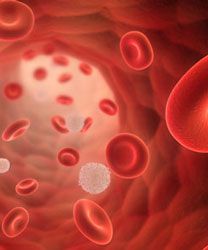POD Within 2 Years of Cytarabine-Containing Treatment Associated With Poor Outcomes in MCL
Patients with relapsed/refractory mantle cell lymphoma (MCL) who experienced progression of disease within 2 years following an upfront chemoimmunotherapy regimen containing high-dose cytarabine were more likely to have worse outcomes than patients who progressed later, according to the results of a retrospective analysis presented at the 2018 European Hematology Association Congress. Alternatively, patients who experienced POD later had an unexpectedly long life expectancy.

Patients with relapsed/refractory mantle cell lymphoma (MCL) who experienced progression of disease (POD) within 2 years following an upfront chemoimmunotherapy regimen containing high-dose cytarabine (HDAraC) were more likely to have worse outcomes than patients who progressed later, according to the results of a retrospective analysis presented at the 2018 European Hematology Association (EHA) Congress.1Alternatively, patients who experienced POD later had an unexpectedly long life expectancy.
“In patients with MCL who received upfront HDAraC-containing regimens, POD within 2 years after diagnosis was associated with poor survival and should be validated as a standard endpoint of chemoimmunotherapy trials of untreated MCL,” lead author Carlo Visco, MD, of the Department of Hematology, San Bortolo Hospital in Vicenza, Italy, and colleagues wrote in their presentation at EHA. “Contrarily, late POD patients had an unexpectedly long life expectancy in the modern treatment era.”
This study, done by Centers of the Fondazione Italiana Linfomi and the MCL Network, analyzed data from 188 patients with MCL that was refractory to and had relapsed after induction to determine if early POD was associated with a high risk of death.
A total of 478 patients were recruited from 26 centers of the Fondazione Italiana Linfomi between January 2007 and June 2016. As of June 2017, 198 of the patients had relapsed or refractory disease. Due to lack of follow-up data, 10 of those patients were excluded from the study, leaving 188 eligible patients.
Patients had a median age of 57 (range, 35-68), and the majority of patients (62%) were under the age of 60. Seventy-six percent of the patients were male (n = 146), and 91% (n = 168) had stage IV disease. Thirty-seven percent of patients (n = 69) had a high Mantle Cell Lymphoma International Prognostic Index (MIPI) score.
Ninety-nine patients (53%) received the Nordic regimen with rituximab (Rituxan)-purged stem cell autografting (R-HDS); 40 patients (21%) received rituximab plus cyclophosphamide, doxorubicin, vincristine, and prednisone (R-CHOP)/dexamethasone, cytarabine, and cisplatin (DHAP) plus autologous stem cell transplantation (ASCT); and 49 patients (26%) received hyper-cyclophosphamide, vincristine sulfate, doxorubicin, and dexamethasone (HyperCVAD)/methotrexate, high-dose cytarabine, and dexamethasone (MTXHDAC).
The HDAraC-containing cohort from the MCL Younger trial was used as an independent validation set. The trial was conducted by the European MCL Network and published inThe Lancetin 2016.2
Between July 2004 and March 2010, this phase III trial randomized 497 MCL patients aged 65 and younger to receive either 6 courses of R-CHOP followed by myeloablative radiochemotherapy and ASCT, or 6 courses of alternating R-CHOP or R-DHAP followed by a HDAraC-containing conditioning regimen and ASCT.
A total of 234 of 249 patients included in the control group and 232 of 248 patients in the cytarabine group were included in the primary analysis. Time to treatment failure was found to be significantly longer in the cytarabine group (median 9.1 years [95% CI, 6.3-not reached]; 5-year rate 65% [95% CI, 57%-71%]) after a median follow-up of 6.1 years (95% CI, 5.4-6.4).
Investigators of the MCL Younger trial concluded that HDAraC followed by ASCT should be considered the standard of care in patients with MCL who are ≤65.
In the retrospective analysis, early POD was defined as ≤2 years after diagnosis and late POD was defined as >2 years. The groups were defined based on a linear progression model showing the relationship between risk of death and time to first relapse or progression in these 188 patients. The primary outcome of the trial was overall survival (OS) from the time of POD (OS-2).
Of the patients who received Nordic/R-DHS, 47 experienced early POD with OS-2 of 12 months and 52 experienced late POD with OS-2 of 47 months. Twenty-two of the patients who received R-CHOP/DHAP+ASCTexperienced early POD with OS-2 of 13 months and 18 experienced late POD with OS-2 not reached. Of the patients who received HyperCVAD/MTXHDAC, 21 experienced early POD with OS-2 of 12 months and 28 experienced late POD with OS-2 not reached.
Overall, 90 patients (48%) experienced early POD with a median OS-2 of 12 months. Ninety-eight patients (52%) experienced late POD, with 55% of the patients experiencing a 5-year OS-2 (P<.0001). Among all of the patients, the median OS-2 was 34 months (range, 25-42).
In multivariate analysis, the most powerful adverse factor was early POD (HR, 3.90; 95% CI, 2.16-7.06). Similar findings were seen in the validation set (HR, 2.85; 95% CI, 1.87-4.86).
Among all of the patients, the median OS from time of initial diagnosis (OS-1) was 76 months (range, 64-88). OS-1 was 27 months in the early POD group and 127 months in the remaining patients.
Investigators noted the impact on survival was independent of other known prognostic variables and was maintained after adjustments were made for MIPI score, tumor kinetics, morphological variant, presence of B-symptoms, varying induction regimens, or allogeneic stem cell transplantation.
References:
- Visco C, Tisi MC, Evangelista A, et al. Time to relapse of mantle cell lymphoma after intensive high dose cytarabine containing regimens defines patients risk for death: an analysis from centers of the Fondazione Italiana Linfomi. Presented at: 2018 EHA Congress; June 14-17, 2018; Stockholm, Sweden. Abstract PS1012.
- Hermine O, Hoster E, Walewski J, et al. Addition of high-dose cytarabine to immunochemotherapy before autologous stem-cell transplantation in patients aged 65 years or younger with mantle cell lymphoma (MCL Younger): a randomized, open-label, phase 3 trial of the European Mantle Cell Lymphoma Network.Lancet.2016;388(10044):565-575. doi: http://doi.org/10.1016/S0140-6736(16)00739-X.








